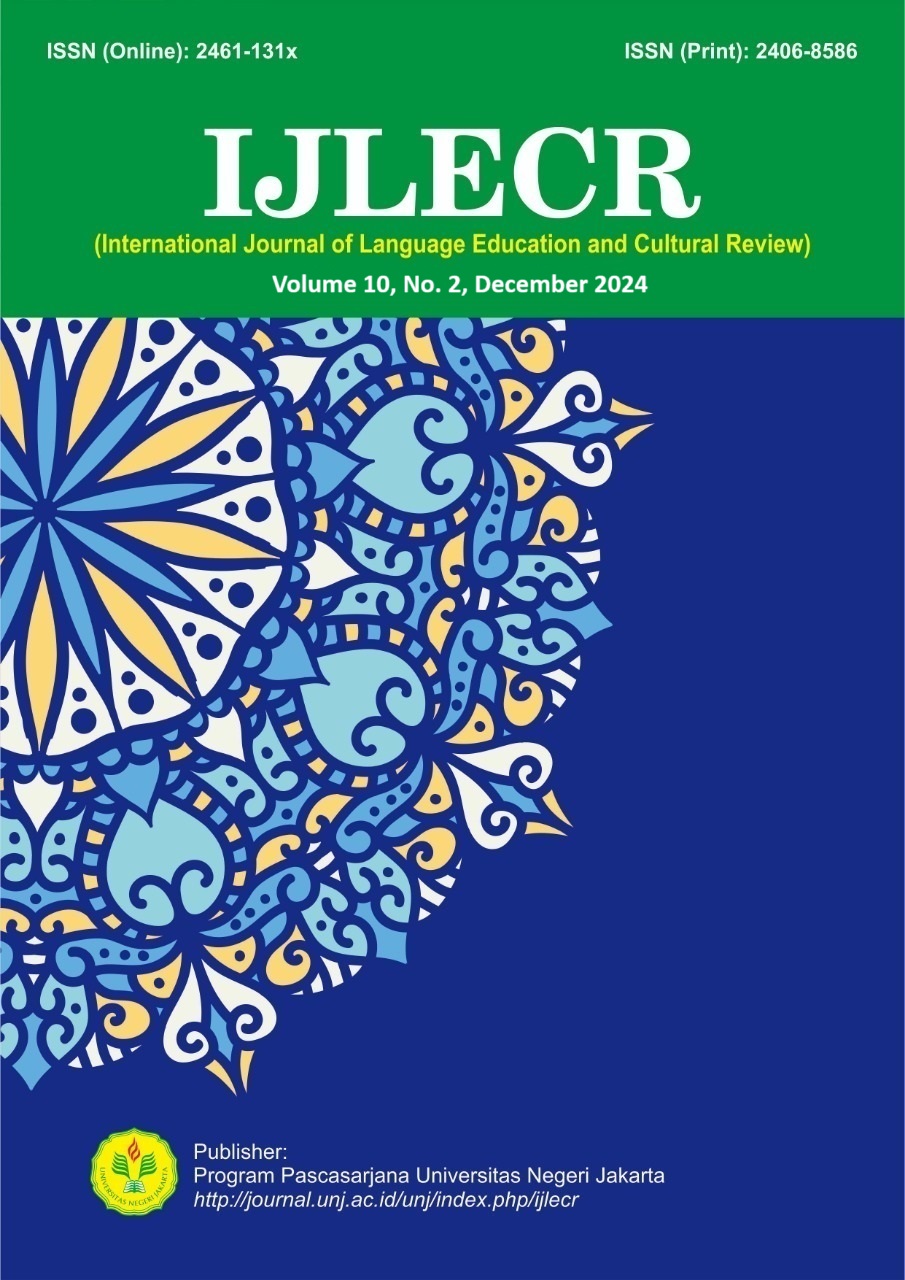Structure of the Vision and Mission Text of the Indonesian Language Education Masters Study Program Accredited as Excellent in Indonesia
DOI:
https://doi.org/10.21009/ijlecr.v10i2.52201Kata Kunci:
Text Structure, Scientific Vision, Scientific Mission, Indonesian Language Education Study ProgramAbstrak
The vision and mission of a study program are the ideals of a study program that can be realized in a certain context and level and have an impact on graduates who have advantages and outputs that are beneficial to the development of science and society. For this reason, it is important to understand the structure of the text of the vision and mission of the study program, especially in this case the vision and mission of the Indonesian Language Education Study Program which is accredited as superior in Indonesia. For this reason, this study aims to describe the structure of the text of the vision and mission of the Indonesian Language Education Study Program which is accredited as superior in Indonesia. The research method uses the Systemic Functional Linguistics method. The data collection technique uses documentation techniques from the study program website. The research data are the vision and mission of science from nine accredited study programs. Data analysis techniques start from constituent structure analysis, grammatical constituent analysis, and labeling based on class or function. The results of the study show that the structure of the scientific vision text has minimal variations, namely ability, study material or material, and context. Meanwhile, the complete structure of the study program's scientific vision text is the ability, study material or material, context, and level of achievement or in a structure that begins with the level of achievement, ability, audience, level of achievement, study material, level of achievement, and context. Then, the structure of the scientific mission text at least has components of ability, study material, and context or with the structure of ability, study material, and level of achievement. Meanwhile, the complete structure of the mission text consists of ability, study material, context, and level of achievement. However, the mission is not an obligation for the study program in compiling it and the obligations that are compiled are the vision and objectives.
Referensi
Aditya, A., (2010). Visi dan Misi Perusahaan. Jakarta: Gramedia Pustaka Utama.
Anderson, L. W., & Krathwohl, D. R. (2001). A Taxonomy for Learning, Teaching, and Assesing: A Revision of Bloom's Taxonomy of Educational Objectives. New York: Addison Wesley.
Arwansyah, Y. B. (2019). Revitalisasi Budaya Lokal sebagai Dasar Pengembangan Keilmuan Berdasarkan Visi dan Misi Perguruan Tinggi di Indonesia. Jurnal Skripta, 5(1). https://doi.org/10.31316/skripta.v5i1.124
Danim, S. (2006). Visi Baru Manajemen Sekolah. Jakarta: Bumi Aksara.
Daud, L. & Nursaid. (2018). Pelaksanaan Visi dan Misi Program Studi Pendidikan Agama Islam dalam Proses Pembelajaran pada Fakultas Ilmu Tarbiyah dan Keguruan IAIN Ambon. Al-Iltizam: Jurnal Pendidikan Agama Islam, 3(2), 109. https://doi.org/10.33477/alt.v3i2.600
Fitriastuti, L. I. (2018). Pemetaan Orientasi Visi Misi Perguruan Tinggi Swasta di Wilayah Kopertis V Yogyakarta. Kajian Ekonomi dan Bisnis, 13(2). https://doi.org/10.51277/keb.v13i2.40
Halliday, M. A. K. (2004). An Introduction to Functional Grammar. New York: Oxpord University Press.
Hariwibowo, R. (2018). Analisis Visi dan Misi Fakultas Ekonomi dan Bisnis Universitas Mulawarman. KINERJA, 15(2), 76. https://doi.org/10.29264/jkin.v15i2.4035
Junaidi, A. (2020). Panduan Penyusunan Kurikulum Pendidikan Tinggi di Era Industri 4.0 untuk Mendukung Merdeka Belajar-Kampus Merdeka. Jakarta: Direktorat Jenderal Pendidikan Tinggi Kementerian Pendidikan dan Kebudayaan.
Karimah, M. (2021). Analisis Visi, Misi, Tujuan dan Kurikulum Dua Sekolah di Wonogiri. Jurnal Penelitian Bidang Pendidikan, 27(1), 1. https://doi.org/10.24114/jpbp.v27i1.14855
Lembaga Akreditasi Mandiri Kependidikan. (2022). Buku 3 Panduan Penyusunan Laporan Evaluasi Diri. Jakarta: Lembaga Akreditasi Mandiri Kependidikan (Lamdik). https://lamdik.or.id/wp-content/uploads/2022/02/Lampiran-5-Peraturan-BAN-PT-2-2022-IAPS-Kependidikan.pdf
Lembaga Akreditasi Mandiri Kependidikan. (2022). Buku 4 Panduan dan Matriks Penilaian. Jakarta: Lembaga Akreditasi Mandiri Kependidikan (Lamdik). https://lamdik.or.id/wp-content/uploads/2022/02/Lampiran-8-Peraturan-BAN-PT-2-2022-IAPS-Kependidikan.pdf
Martin, J. R. (2015). Cohesion and Texture. In Tannen, D., Hamilton, H.E., & Schiffrin, D., Eds., The handbook of discourse analysis (2ndEd). Oxford: John Wiley & Sons, 61-80.
Susanto, A.B. (2008). Visi dan Misi: Langkah Awal Menuju Strategic Management. Jakarta: The Jakarta Consulting Group.
Wiratno, T. (2018). Pengantar Ringkas Linguistik Sistemik Fungsional. Yogyakarta: Pustaka Pelajar.








